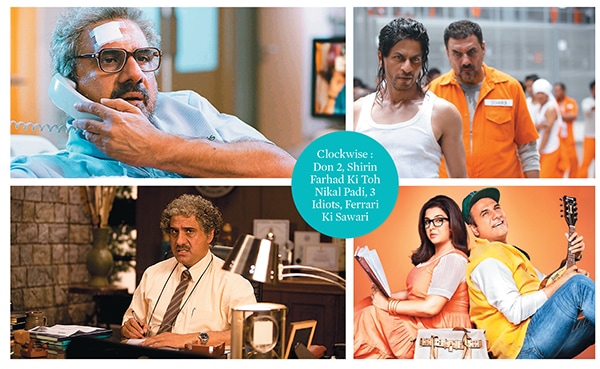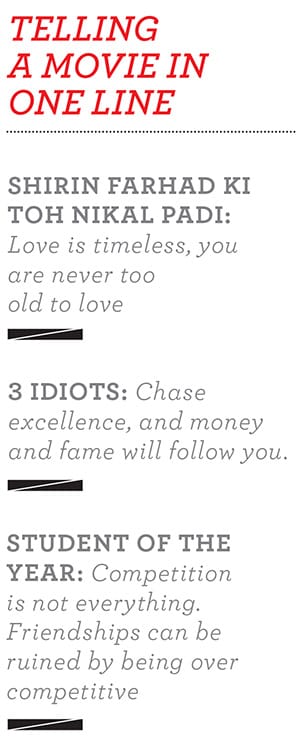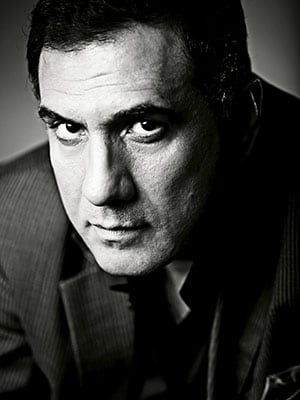
Being Boman Irani
The Munnabhai MBBS actor took a punt past 40 when he went from behind the camera to face it. Then, at 53, he broke into the big league
I do a lot of movies. I have done 63 movies in under 10 years. That’s a hell of a lot. And the reason why I could do it is that I am not a lead actor, which means that my work in a film is 15-20 days’ work, while a lead actor will work for about 45 days. That way, I can do more films but I am cutting down on it.
The pressure to do movies should not be money-driven. There might have been wonderful amounts of money that may have come in but I don’t do a film. I might do a stupid film but there is a reason. I will do it for a friend, I will do it for somebody who is trying to get a break or a comeback. Why did I do Batuk Patel [Housefull]? Sajid [Khan] had told me five years ago: “When I make my debut film, give me your word that you will be part of it.” And I had said: “Done.” I was in England and they were shooting there and they needed four days. I had a reason. I was offered to do his fourth film also —Himmatwala—but it needed a lot of time (35 days) so it was not possible.
PITCH IT RIGHT
I choose my roles on “the pitch”. A one-line pitch is a must. Then the story in a nutshell. Narrate your opening sequence. Narrate your climax because in India scripts are not written comprehensively. (And I am sorry to say this.) Narrate the director’s favourite sequence in the movie. We know the beginning. We know the ending. We know the high point of the film. If these attract me, I ask the director to send me the script. Because I know where the director is going with it, I know what’s exciting him. And then the main question: Why do you want to make the film? If he says I want to make an out-and-out entertainer, I am fine with that. If somebody says that, he is being honest.
You are building a brand as an actor. Nobody is actually interested in how much money you have. At least that’s not what I am interested in. I am interested in a good life. Maybe get the things I was always interested in as a teenager which I could not afford. For instance, I have this giant screen in my home and I am happy. I get to travel as and when I want, I am happy. Money doesn’t drive me crazy. I would rather lose my sleep over a role that I am unprepared for, lose it enough to be prepared for it. It is my high. It is my substance. And I will abuse that substance as long as I live.
THE WRITE WAY
I think we are undermining the importance of a supporting actor. Remember the supporting actor, especially the antagonist, is always alone. He is the stumbling block. The greatest thing about the performance in Khosla Ka Ghosla is the writing. I will tell you why. It is not about how the character is portrayed. It is about how the character has been written before it comes on screen. That’s the beauty. Arre who saap addmi hai… Khurana… hahahahha…. bahut danger cheez hai yaar [He’s a snake…Khurana…he is dangerous]. You say who the #$%# is Khurana, man? Khurana ne mera zameen le liya. Aur abhi uska ho gaya…usne deewar banake rakh di. Abhi akhade se log leke gaya…usko jail me dalwa diya. [Khurana grabbed my land…now it’s his…he’s built a wall around it. He’s got in wrestlers…he’s put him in jail].
Anupam Kher is all there but I am still not on screen. There is this famous character in The Third Man called Harry Lime played by Orson Welles. He comes in the last 20 minutes of the film but in the whole movie they are talking about who is Harry Lime. It is like Gabbar Singh. Gabbar aisa hai, Gabbar waisa hai [Gabbar this, Gabbar that]…finally when Gabbar comes you are s***ting in your pants. You have not seen him, you have not seen the newcomer, you have just seen his legs but you are s***ting. Why? Because the writer has set him up brilliantly. Similarly, in Khosla ka Ghosla…you talk about him and then finally he puts his hand on Anupam Kher’s shoulder and says, “Uncleji…”. Whoa, he has come! That is the greatest thing.

DIFFERENT STROKES
I like to be unique. If it is a role and it has been done 500 times before and if it has been done by me before, it will be different from the other one. If I am playing a Punjabi builder in one film, the other Punjabi builder will be different. I have played four Parsis in movies—Little Zizou, Being Cyrus, Ferrari Ki Sawari and Shirin Farhad Ki Toh Nikal Padi…all four are different. This is not even the Parsi I am. When I am playing a sardar, my reference point will not be sardars played by other actors. They will be sardars in real life.
There has to be some process. To me, the process is the game. If you get on to a film set and say I will try and build a character on a film set, it is not going to happen. It happens over a period of time. It happens when you sit with a character and when you wake up at night to go to the washroom, you should be thinking about that character. It should be important enough for you. I built the character of Khurana in Khosla Ka Ghosla out of fear. I live in the fear of failure. I had taken up this responsibility from the writer, the director, the producer and the money. You’ve got to deliver.
NUMBER PROBLEM
I was born posthumously [in 1959].
My father died six months before I was born. So I was born in this family full of women. It was crazy. So I didn’t have men in my life at that point of time. So I was a very scared child.
I had to have been dyslexic in my early years. I realised that in school. It was not diagnosed but I still feel it. I still read numbers funny. You give me a number, I will punch it in wrong. I have no understanding of numbers, I have to count on my fingers sometimes. Then I had a speech problem so I couldn’t speak correctly till I was nine. I went to a therapist and got that corrected. Then, of course, I haven’t shut up since.
WHEN THE SHOW BEGAN
I wasn’t a bright student. I took up a waiters’ course and joined the Taj Mahal Hotel [in Mumbai]. I was a terrific waiter. Because I spoke well, I had a reasonable sense of humour, I could quip back without being irreverent. There I really toughened up. I spent about two years there.
Then my mom met with an accident. She was running our family business, which was a wafer shop. It was called Golden Wafers. It was right in the heart of the cinema district of Bombay. Novelty cinema, Apsara cinema—Apsara is gone, Minerva is gone, Novelty is more or less over. So that was my connect to cinema. I used to live in Bellasis Road and I spent my childhood in Alexandra cinema. I would go and see a show every day.
Photograph: Yogen Shah / Getty Images; Infographic: Sameer Pawar

WHAT CLICKED
When I was 27, I picked up this whole fascination for photography. I used to read National Geographic and Sportsweek and Sportstar. And I used to love the pictures. So I started contributing to them. I would go and shoot an event other photographers would not consider important enough. I got a lovely job at the boxing world cup, courtesy Aspi Adajania. I got an inside view and I sold some pictures to the foreign boxers there. I got a pretty, pretty penny for doing that and that gave me an impetus to say that you can make a livelihood out of this. MRF had sponsored the boxing event, later I went to Chennai to photograph their campaign “the tyres we race are the tyres you buy”. That was shot by me.
At that time, [choreographer] Shiamak Davar came into my life.

ON THE STAGE
Shiamak said: “You are an actor, you have got the face and the expression of a theatre person. You have got the voice of a theatre person.” He took me to Alyque Padamsee who put me on a show called Roshni. I did one scene in the play. The next play I did was I'm not Bajirao, which became a sensation. So the next thing I know is I am working with Sudhir Joshi. On New Year, my mom said it is one of her wishes that I do a remake of I am not Bajirao, but I can’t do it without Sudhir. It was an experimental play for which we had booked just three shows and it ran for 10 years full house till the day Sudhir died.
I knew a reasonable amount of acting through interviews, books, legendary myths of what Robert De Niro did, what Al Pacino did and I would read that and apply it. And I thought that’s the way to do it. These people study characters, so I went and studied an old man. I would go to a park, sit with old people, take photographs, make videos and come back home and study them. I would really, really work on it. And suddenly movie offers started coming. For five to six years, I refused films because I was doing theatre over the weekend and my photography career had just picked up.
THE FIRST CUT
Vidhu Vinod Chopra saw an experimental film I had shot on digital video called Let’s Talk. I did that movie and the director tells me this movie is not going to get released anywhere, so let’s watch it ourselves. So we had a premiere in the house. Red carpet lagaya, mat lagaya, champagne piya [we rolled out the red carpet, drank champagne], 15 of us watched, and that’s it. Vinod Chopra managed to see that film as Ram [Madhvani, the director of Let’s Talk] had shot Mission Kashmir’s climax. When I met him, he gave me a cheque. Four months later, he calls me and says: “I have a movie called Munnabhai MBBS. And I want you to do a role in it.” I didn’t like the sound of it. Then, after dithering for four to five months, I met Raju [Rajkumar Hirani]. They went and asked Amrishji [Amrish Puri], he said no. They asked Pareshbhai [Paresh Rawal], he said no. I met Raju in his office and I loved the man. Then he narrated the story to me and he did it with such passion and with such clarity that I said I will be fool if I don’t do this.
True calling
Now, I have got to change the reason why I am doing movies. I have got to do fewer films because a friend asked me to. I should gain happiness out of the film rather than the happiness I gave a friend by being in his film. The friends don’t need me anymore. I want to do films I want to spend time over and enjoy. I also want to make a movie. It is about time I did that. I never wanted to be an actor, by the way. As a child, I followed filmmakers. I never followed actors.
(As told to Ashish K Mishra & Shishir Prasad)
(This story appears in the 30 November, -0001 issue of Forbes India. To visit our Archives, click here.)





